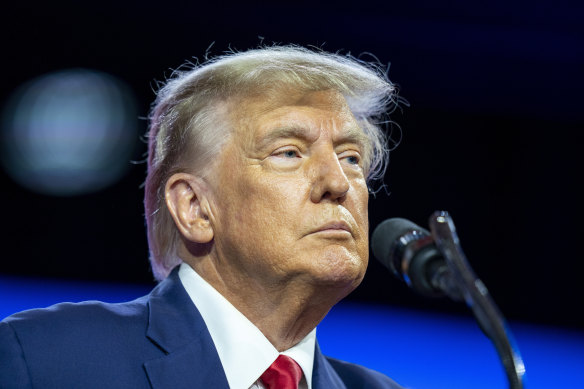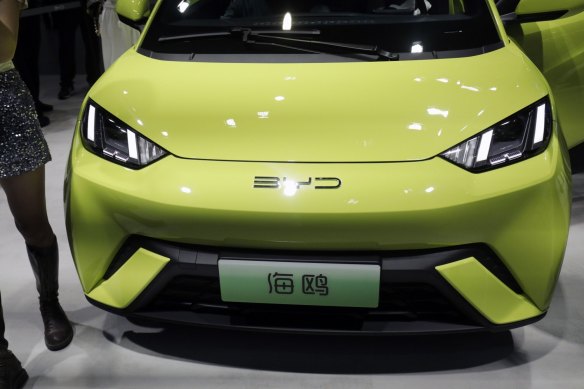This was published 1 year ago
Opinion
Donald Trump’s attack on China might backfire
Stephen Bartholomeusz
Senior business columnistAmerica’s trade war with China resembles a game of whack a mole. It’s lowered the US trade deficit with China but greatly increased deficits elsewhere.
Last week’s US trade data has taken on greater significance given Donald Trump’s proposed aggressive new tariffs on China and America’s other trade partners should he win office again at this year’s US elections, where the once-improbable is now looking ever more likely.

Donald Trump has proposed aggressive new tariffs on China and America’s other trade partners should he win office again.Credit: AP
Trump has said he will increase the current tariffs on China’s exports to the US, which are as high as 25 per cent, to 60 per cent while imposing a “ring around the collar” of the US economy in the form of a universal 10 per cent minimum tariff on all other imports.
With Trump’s team also targeting Europe for, not just the US trade deficit but the European Union’s Digital Services Act taxes, which particularly impact the big US technology companies, they envisage a massive escalation of trade hostilities relative to the trade wars Trump initiated in 2018.
While Joe Biden has unwound some of the tariffs on European imports and the trade (and broader) relationship with Europe has improved dramatically under his administration, he has kept Trump’s tariffs on China’s exports to the US intact, largely because of the domestic political implications of being seen to be soft on China.
Moreover, the administration has added new trade sanctions targeting Chinese companies and industries seen as critical to the geopolitical and technological rivalry between the two countries, with a central focus being an attempt to deny China access to the advanced semiconductors that are the building blocks of new technologies.
Biden’s Inflation Reduction Act has massive subsidies for investment in domestic manufacturing of “clean” technologies while screening the investment to exclude participation by those economies that don’t have free trade agreements with America.
Relative to the world of trade before Trump, the world trade order has been convulsively reordered and distorted by America’s more protectionist stance and now, despite a near-consensus that it has been American companies and consumers that have borne the cost of the tariffs on China and that it has cost US jobs, Trump plans to more than double up on his earlier assault on global trade.
Last week’s data provided something of a scorecard on the success of America’s trade wars.
At face value, it would appear the US is winning, particularly in the efforts to reduce imports from China.

While Joe Biden has unwound some of the tariffs on European imports he has kept Trump’s tariffs on China’s exports to the US intact.Credit: AP
The US goods trade deficit with China last year was, at $US279 billion ($428 billion), the smallest deficit since 2010 and, at one per cent of US GDP, the lowest level in more than two decades.
Indeed, America’s overall trade deficit in goods shrank from $US1.2 trillion in 2022 to $US1.2 trillion. As a share of GDP it was 3.9 per cent, the lowest in a decade.
So, does that mean America is winning the trade wars?
Not really, given that Americans bear the costs of the tariffs and the size of a trade deficit or surplus has more to do with savings and investment flows and, in America’s case, dollar dominance than tariffs.
The shrinkage in the overall goods trade deficit also has more to do with what happened in 2021 and 2022 when, aided by the massive fiscal response to the pandemic, US consumers gorged on consumer goods, expanding both the overall deficit and the deficit in trade with China. With conditions normalising last year, that demand reduced.
There is a structural element to the shrinking deficit with China, given how the bulk of America’s trade sanctions have been focused on its economy and exports.
But that’s where the whack-a-mole analogy becomes relevant. As the US has hit China’s exports, its current account deficits with other countries – most particularly Mexico and Vietnam – have blown out.
The US trade deficit with Mexico was $US152 billion last year. That’s the highest level in more than a decade-and-a-half and more than double their level in 2017, before Trump took office and not only ignited the trade war with China but renegotiated the North American Free Trade Agreement with Mexico and Canada what he said was “the most balanced trade agreement in the history of our country.”

The US is also considering restrictions, beyond the tariffs, on imports of Chinese EVs or EV components because of concerns about the ability of smart cars to collect vast amounts of data.Credit: Bloomberg
The trade data shows that the combined goods trade deficits with Mexico and Canada last year totalled $220 billion. In 2017, they were $US85 billion.
It’s no coincidence that imports from Mexico and Vietnam have soared since Trump ignited the trade wars, with the pandemic and the way it exposed the vulnerability of extended global supply chains no doubt amplifying the underlying shifts in the patterns of US trade.
Nor is it a coincidence that, in response to the trade war, Chinese exports to, and investment in, Vietnam and Mexico have risen dramatically.
Chinese exporters have been exporting semi-finished goods and components to Vietnam and other Asian economies that are then re-exported to the US. Chinese companies have been doing something similar, and investing directly in factories, in Mexico.
Trump plans to more than double up on his earlier assault on global trade.
In effect, they are seeking and gaining a low-to-zero tariff back door entry into the US.
Mexico, given the free trade agreement, is particularly attractive for exports of components or direct investment and, with the personal involvement of Xi Jinping in seeking greater co-operation, bilateral trade between China and Mexico, and China’s exports to Mexico in particular, have been soaring.
The potential for China to use Mexico as a back door to its markets, particularly for its electronic vehicles that have been frozen out by the high tariff barrier, hasn’t been lost on the US.
Late last year the US and Mexico (far more dependent on the US economy and broader relationship than on China) agreed to monitor and screen foreign investment and share information to ensure that Mexico isn’t conduit for parties seeking to circumvent America’s tariffs or to threaten its national security interests.
The US is also considering restrictions, beyond the tariffs, on imports of Chinese EVs or EV components – whether directly from China or via third countries – because of concerns about the ability of smart cars to collect vast amounts of data.
Chinese authorities have banned even Chinese-manufactured Teslas from proximity to government and military sites on national security grounds. With a number of China’s big EV manufacturers exploring investment in Mexico, the US is likely – certainly, if Trump were president – to emulate them.
Trump’s tariffs have changed the trade flows between China and the US, adding complexity and costs as China’s exports are squeezed only to see bulges appear elsewhere.
It was always, however, too simplistic to see, as Trump, the self-described “Tariff Man” did, trade wars as being “good and easy to win.” International trade is too adaptable and there is too much demand for goods that either can’t be manufactured in the US, or are far more expensive to manufacture there.
Trump might think building a higher tariff wall will somehow completely shut out imports and stop foreigners “taking advantage” of America by selling it cheaper or better products. If he gets the opportunity, however, he might well find that his tariff wall is as porous as his border wall or, even worse, that he has unleashed another wave of unacceptably high inflation and a fierce assault on Americans’ living standards.
The Business Briefing newsletter delivers major stories, exclusive coverage and expert opinion. Sign up to get it every weekday morning.